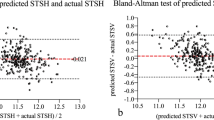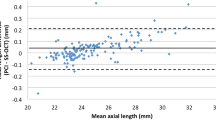Abstract
Purpose
The aim of this study was to determine the correlation between ocular biometric parameters and sulcus-to-sulcus (STS) diameter.
Methods
This was a cross-sectional study of preoperative ocular biometry data of patients who were candidates for phakic intraocular lens (IOL) surgery. Subjects underwent ocular biometry analysis, including refraction error evaluation using an autorefractor and Orbscan topography for white-to-white (WTW) corneal diameter and measurement. Pentacam was used to perform WTW corneal diameter and measurements of minimum and maximum keratometry (K). Measurements of STS and angle-to-angle (ATA) were obtained using a 50-MHz B-mode ultrasound device. Anterior optical coherence tomography was performed for anterior chamber depth measurement. Pearson’s correlation test and stepwise linear regression analysis were used to find a model to predict STS.
Results
Fifty-eight eyes of 58 patients were enrolled. Mean age ± standard deviation of sample was 28.95 ± 6.04 years. The Pearson’s correlation coefficient between STS with WTW, ATA, mean K was 0.383, 0.492, and − 0.353, respectively, which was statistically significant (all P < 0.001). Using stepwise linear regression analysis, there is a statistically significant association between STS with WTW (P = 0.011) and mean K (P = 0.025). The standardized coefficient was 0.323 and − 0.284 for WTW and mean K, respectively. The stepwise linear regression analysis equation was: (STS = 9.549 + 0.518 WTW − 0.083 mean K).
Conclusion
Based on our result, given the correlation of STS with WTW and mean K and potential of direct and essay measurement of WTW and mean K, it seems that current IOL sizing protocols could be estimating with WTW and mean K.

Similar content being viewed by others
References
(2009) Phakic intraocular lenses for the treatment of refractive errors: an evidence-based analysis. Ont Health Technol Assess Ser 9(14):1–120. https://www.ncbi.nlm.nih.gov/pmc/articles/PMC3377525/
Rabsilber TM, Jepsen C, Auffarth GU, Holzer MP (2010) Intraocular lens power calculation: clinical comparison of 2 optical biometry devices. J Cataract Refract Surg 36(2):230–234
Alfonso JF, Fernandez-Vega L, Lisa C, Fernandes P, Jorge J, Montes Mico R (2012) Central vault after phakic intraocular lens implantation: correlation with anterior chamber depth, white-to-white distance, spherical equivalent, and patient age. J Cataract Refract Surg 38(1):46–53
Huang D, Schallhorn SC, Sugar A, Farjo AA, Majmudar PA, Trattler WB et al (2009) Phakic intraocular lens implantation for the correction of myopia: a report by the American Academy of Ophthalmology. Ophthalmology 116(11):2244–2258
Lovisolo CF, Reinstein DZ (2005) Phakic intraocular lenses. Surv Ophthalmol 50(6):549–587
Sayed KM, Alsamman AH (2015) Interchangeability between Pentacam and IOLMaster in phakic intraocular lens calculation. Eur J Ophthalmol 25(3):202–207
Goldsmith JA, Li Y, Chalita MR, Westphal V, Patil CA, Rollins AM et al (2005) Anterior chamber width measurement by high-speed optical coherence tomography. Ophthalmology 112(2):238–244
Rondeau MJ, Barcsay G, Silverman RH, Reinstein DZ, Krishnamurthy R, Chabi A et al (2004) Very high frequency ultrasound biometry of the anterior and posterior chamber diameter. J Refract Surg 20(5):454–464
Reinstein DZ, Archer TJ, Silverman RH, Rondeau MJ, Coleman DJ (2009) Correlation of anterior chamber angle and ciliary sulcus diameters with white-to-white corneal diameter in high myopes using artemis VHF digital ultrasound. J Refract Surg 25(2):185–194
Werner L, Izak AM, Pandey SK, Apple DJ, Trivedi RH, Schmidbauer JM (2004) Correlation between different measurements within the eye relative to phakic intraocular lens implantation. J Cataract Refract Surg 30(9):1982–1988
Pop M, Payette Y, Mansour M (2001) Predicting sulcus size using ocular measurements. J Cataract Refract Surg 27(7):1033–1038
Alio JL, de la Hoz F, Perez-Santonja JJ, Ruiz-Moreno JM, Quesada JA (1999) Phakic anterior chamber lenses for the correction of myopia: a 7-year cumulative analysis of complications in 263 cases. Ophthalmology 106(3):458–466
Perez-Santonja JJ, Iradier MT, Benitez del Castillo JM, Serrano JM, Zato MA (1996) Chronic subclinical inflammation in phakic eyes with intraocular lenses to correct myopia. J Cataract Refract Surg 22(2):183–187
Javaloy J, Alio JL, Iradier MT, Abdelrahman AM, Javaloy T, Borras F (2007) Outcomes of ZB5 M angle-supported anterior chamber phakic intraocular lenses at 12 years. J Refract Surg 23(2):147–158
Wang L, Auffarth GU (2002) White-to-white corneal diameter measurements using the eyemetrics program of the Orbscan topography system. Dev Ophthalmol 34:141–146
Martin R, Ortiz S, Rio-Cristobal A (2013) White-to-white corneal diameter differences in moderately and highly myopic eyes: partial coherence interferometry versus scanning-slit topography. J Cataract Refract Surg 39(4):585–589
Baumeister M, Terzi E, Ekici Y, Kohnen T (2004) Comparison of manual and automated methods to determine horizontal corneal diameter. J Cataract Refract Surg 30(2):374–380
Salouti R, Nowroozzadeh MH, Zamani M, Ghoreyshi M (2009) Comparison of horizontal corneal diameter measurements using Galilei, EyeSys and Orbscan II systems. Clin Exp Optomol 92(5):429–433
Oh J, Shin HH, Kim JH, Kim HM, Song JS (2007) Direct measurement of the ciliary sulcus diameter by 35-megahertz ultrasound biomicroscopy. Ophthalmology 114(9):1685–1688
Dong EY, Joo CK (2001) Predictability for proper capsular tension ring size and intraocular lens size. Korean J Ophthalmol 15(1):22–26
Wojciechowski R, Congdon N, Anninger W, Teo Broman A (2003) Age, gender, biometry, refractive error, and the anterior chamber angle among Alaskan Eskimos. Ophthalmology 110(2):365–375
Acknowledgements
The authors thank all the subjects who contributed in clinical data gathering (Mrs. Mohammadinia) and statistically consultation (Prof. A. Feizi) but not complete authorship criteria in this study.
Author information
Authors and Affiliations
Corresponding author
Ethics declarations
Conflict of interest
The authors declare that they have no conflict of interest.
Ethical approval
For this type of study formal consent is not required.
Rights and permissions
About this article
Cite this article
Ghoreishi, M., Abdi-Shahshahani, M., Peyman, A. et al. A model for predicting sulcus-to-sulcus diameter in posterior chamber phakic intraocular lens candidates: correlation between ocular biometric parameters. Int Ophthalmol 39, 661–666 (2019). https://doi.org/10.1007/s10792-018-0859-5
Received:
Accepted:
Published:
Issue Date:
DOI: https://doi.org/10.1007/s10792-018-0859-5




